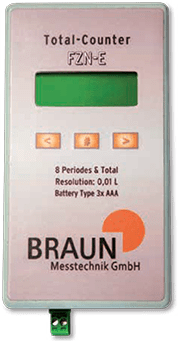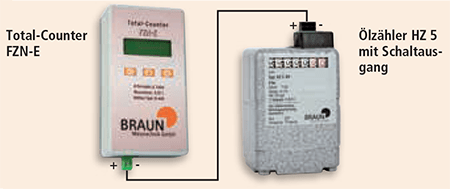The Universal Impulse Meter

Whether remote display for counting devices, independent pulse or event counters, the Total Counter counts what should be counted.
Common Application
- The “Total Counter” pulse counter is used as a remote display for type HZ-5 oil meters and others that have a potential-free contact output.
- The resolution is 0.01 liters. The Total-Counter is also available as an OEM variant with customer-specific programming.
- As a convenient extension of a standard counter, in addition to the Total-Counter, 10 period counters are included, which make it possible to save the respective consumption of a period and compare it with the previous year's values.
- The period memories are designed as ring counters, so that when the 10 periods are exceeded, the oldest value is overwritten with the new value.
Exact Consumption Monitoring
Total-Counter FZN-E
The Total Counter FZN-E counts pulses that are provided by the heating oil meter HZ-5 with a precision of 0.01 liters.
The counter contains a Total-Counter and 10 counters in which the consumption of individual heating periods can be saved, so that a comparison with the previous years is possible.
The device is supplied with 3 standard Mignon batteries, with alkaline batteries the meter can be operated for approx. 5 years, with lithium batteries for approx. 10 years.
The batteries should be replaced if the display is poor or unreadable. When changing the battery, the decimal places of the counter are lost; if the decimal places are important, carry them out if the decimal places are O and the burner is switched off, while the battery cannot be counted.
The full liters without decimal places are saved in a non-volatile memory and remain permanently in the meter.
In the counters of the individual heating periods (ring counter type, the last 10 heating periods can be saved, then the 1st heating period is overwritten with the 11th, the 2nd with the 12th etc.) only the full liters can be saved without decimal places.
Each time a heating period is saved, a counter showing the current heating period is increased by 1 to max. 255 increased so that it remains visible which period is currently being counted.
The device does not require any operation or configuration, but allows you to use the control buttons to call up the meter readings and permanently saved memory contents (even when the battery is changed).
Description Count
The Total Counter FZN-E counts pulse edges, i.e. falling (contact closed) or rising (contact open) voltage curves, which enables a higher resolution with the lowest power consumption.
With 50 pulses of the HZ-5 (50 times falling and rising voltage), this results in a resolution of 0.01 liters.
It contains a 9 + 2 digit total counter and 10 counters that store the consumption of the individual heating periods. The period counter is programmed as a ring memory, the consumption of the 11th heating period is saved in the 1st period counter, the 12th period in counter 2 etc.
There are 2 counter types in the Counter FZN-E, a RAM memory that is updated with every incoming pulse edge, the memory content is maintained as long as the device is supplied with voltage, with alkaline-manganese batteries for approx. 5 years.
The other is an EEProm memory, which is updated every full liter, the memory content is retained even in the event of a power failure.
Even if the display is no longer legible (battery voltage is now below 3.5V, new 4.5V), the counter continues to work until the battery voltage has dropped to 1.8V, meaning that the batteries are completely used up. All memory contents are also written to the non-volatile memory (EEProm).
Description impulse
The Total Counter FZN-E is a display device which uses pulse formers (potential-free contacts, reed contacts with or without protective circuit) to evaluate and count the pulse edges generated.
Many battery-operated devices do not have a pulse output, since this cannot protect the internal battery against discharge when a voltage pulse is passed on, rather it is likely that the internal battery of a device will discharge because the receiver of the pulse or its internal resistance is rarely known.
Even if that were the input resistance, it would have to be a few megohms in order not to significantly load the battery of the pulse generator.
A pulse shaper, on the other hand, expects a voltage which is formed into a pulse by the switching contact, the + line then carries the voltage provided by the counter when the contact is open and carries no or only a low voltage potential when the contact is closed.
The oil meter HZ5 with switching output provides such a pulse shaper stage with which it is possible to record, forward or display the meter reading at a remote location with pulse accuracy.

Control buttons
If the counter is connected, the software counter first counts the decimal places, with every full liter the status is transferred to the hardware counter. The status of the total counter and the period counter 1 are identical until the end of heating period 1.
Pressing the ’#’ button shows the status of the period counter for 5 seconds, then the display changes to the total counter for another 5 seconds.
The display goes out without a further key press.
Pressing the ’>’ button causes a heating period to end, this process must be confirmed 3 times with the ’#’ button to prevent accidental saving.
If this confirmation is made 3 times, the liter-accurate status of the 1st period is saved, the counter for the heating period is set to 2, displayed and then the period counter is reset. Any button other than ‘#’ to confirm will terminate the end of the heating period.
Pressing the ’<’ button shows the contents of the EEProm memory. In the first position there is the status of the total counter, in the 2nd – 11th position the status of the periods 1 – 10 (or 11 – 20, 21 – 30, etc.). These storage areas are only saved every 100 liters.
The next positions contain the number of the current heating period, followed by a pointer that points to the counter byte for all values under 100 liters. All meter readings under 100 liters are in the following memory areas, with a value of 255 indicating that this byte has not yet been written to. You can navigate to the next entry with the ’>’ button. If no button is pressed for 10 seconds, the display is switched off.
